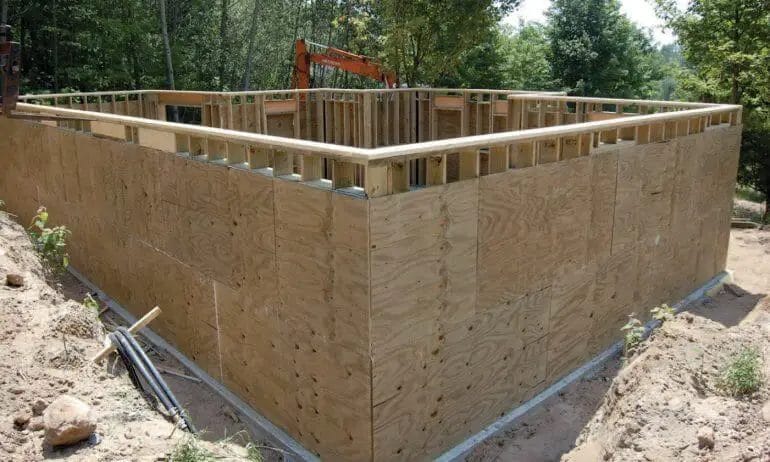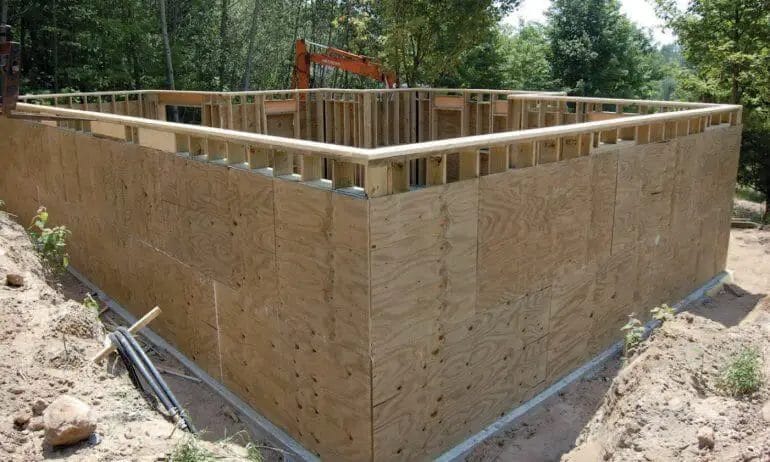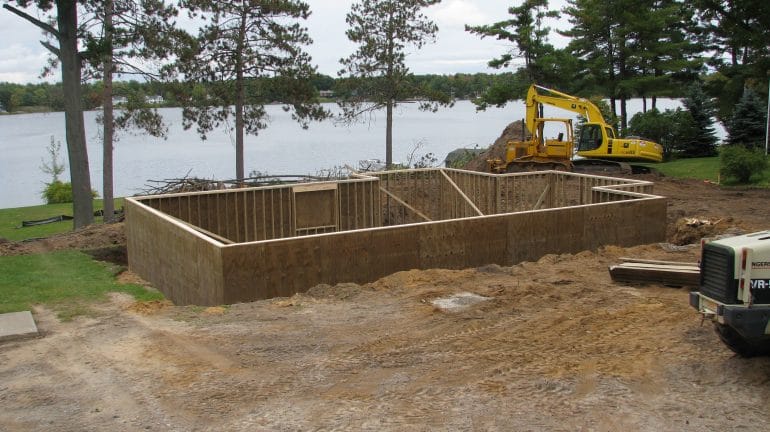A wood foundation is a versatile and cost-effective alternative to traditional concrete or masonry foundations. Building a wood foundation requires careful planning and precise construction techniques to ensure durability and stability. Whether you’re constructing a shed, cabin, or even a small house, a wood foundation can provide a solid base for your structure. In this guide, we’ll walk you through the steps to build a wood foundation, from preparing the site to framing the structure and finishing the foundation.
Before starting the construction process, it’s important to check local building codes and regulations to ensure compliance. You’ll also need to gather the necessary tools and materials for the project, such as pressure-treated lumber, galvanized nails, and a level.

The first step in building a wood foundation is to prepare the site. This involves clearing the area of any debris, rocks, or vegetation and leveling the ground. Next, you’ll need to lay out the dimensions of the foundation using stakes and string. It’s crucial to ensure that the dimensions are accurate and square, as this will determine the stability and integrity of the foundation.
Once the site is prepared, you can begin the construction of the wood foundation. This typically involves creating a framework using pressure-treated lumber. The framework consists of sill plates, floor joists, and cross beams, which are securely fastened together using galvanized nails or screws. It’s important to follow the specific construction plans and techniques to ensure a sturdy and level

Planning and Preparing the Site for a Wood Foundation
Before constructing a wood foundation, it is essential to properly plan and prepare the site to ensure a stable and long-lasting structure. Here are the steps to follow:
1. Site Selection:
Choose a suitable location for your wood foundation. Consider factors such as soil conditions, drainage, and proximity to trees or other structures. The site should be level and free from any obstructions or potential hazards.
2. Permits and Regulations:
Check with your local building department to determine if any permits or regulations apply to building a wood foundation in your area. Make sure to obtain any necessary permits and comply with all building codes and regulations.
3. Clear the Site:
Clear the site of any vegetation, rocks, or debris that may interfere with the construction process. Level the ground if necessary to ensure a uniform base for the foundation.
4. Excavation:
Excavate the site to the required depth for the foundation. The depth will depend on factors such as the climate, soil type, and the load-bearing capacity required for your structure. It is recommended to consult a structural engineer or a local building professional for guidance.
5. Foundation Design:
Design the wood foundation according to the specific requirements of your project. This includes determining the size, shape, and layout of the foundation. Consider factors such as the weight of the structure, the type of wood to be used, and any additional features or reinforcements needed.
6. Drainage:
Install a suitable drainage system to prevent water accumulation around the foundation. This may include installing perimeter drains, gravel layers, or a sump pump if necessary. Proper drainage is essential to prevent water damage and ensure the stability of the wood foundation.
7. Treated Lumber:
Use pressure-treated lumber for the construction of the wood foundation. Pressure-treated wood is treated with preservatives to protect against decay, insects, and moisture. This will enhance the durability and longevity of the foundation.
8. Foundation Anchors:
Install foundation anchors to secure the wood foundation to the ground. These anchors provide stability and prevent the foundation from shifting or moving over time. Follow the manufacturer’s instructions for proper installation.
9. Building Inspection:
Arrange for a building inspection at various stages of the construction process. This will ensure that the wood foundation is built to code and meets all safety requirements. Contact your local building department to schedule inspections as needed.
10. Additional Considerations:
Take into account any additional considerations specific to your project, such as insulation, ventilation, and access points. These factors will depend on the intended use of the structure and any local regulations that apply.
In summary, planning and preparing the site for a wood foundation is a crucial step in ensuring a stable and durable structure. By following the outlined steps and consulting with professionals when needed, you can create a solid foundation that will support your construction project for years to come.

Step-by-Step Guide to Building a Wood Foundation
Building a wood foundation is a great way to provide a sturdy base for various structures, such as sheds, decks, or even small buildings. In this guide, we will walk you through the step-by-step process of building a wood foundation, ensuring that you have a solid and long-lasting structure.
Materials You Will Need:
- Pressure-treated wood boards
- Concrete blocks or piers
- Gravel or crushed stone
- Hammer
- Level
- Tape measure
- Power drill
- Galvanized screws
- Shovel
- String
Step 1: Site Preparation
Start by selecting a suitable location for your wood foundation. Ensure that the ground is level and free from any obstructions. Clear away any vegetation or debris from the site.
Step 2: Determine the Dimensions
Measure and mark the dimensions of your desired foundation using string and stakes. Ensure that the corners are square by measuring diagonally from corner to corner. Adjust the string as needed to achieve equal measurements.
Step 3: Excavation
Use a shovel to excavate the marked area to a depth of about 6 inches. Make sure to remove any roots, rocks, or other debris from the excavation site.
Step 4: Level the Ground
Use a level to ensure that the ground is even and flat. Add or remove soil as needed to achieve a level surface. Tamp down the soil to compact it and create a stable base.
Step 5: Install Concrete Blocks or Piers
Place concrete blocks or piers at regular intervals along the perimeter of the excavated area. These will serve as the support for the wood foundation.
Step 6: Lay Gravel or Crushed Stone
Spread a layer of gravel or crushed stone over the excavated area. This will provide drainage and prevent moisture buildup under the wood foundation.
Step 7: Frame the Foundation
Using pressure-treated wood boards, create a frame along the perimeter of the excavated area. Secure the boards together using galvanized screws to form a sturdy foundation frame.
Step 8: Install Cross Bracing
To further strengthen the foundation, install cross braces diagonally between the frame boards. This will help distribute the weight evenly and prevent any warping or shifting.
Step 9: Secure the Frame to the Supports
Attach the foundation frame to the concrete blocks or piers using galvanized screws. Make sure the frame is level and secure in place.
Step 10: Treat the Wood
Apply a wood preservative or sealant to protect the wood from moisture and rot. Allow the treatment to dry completely before proceeding to the next step.
Step 11: Install the Flooring
Once the foundation is complete, you can proceed with installing the flooring material of your choice. This could be plywood, composite decking, or any other suitable material.
Step 12: Inspect and Maintain
Regularly inspect the wood foundation for any signs of damage or decay. Take necessary measures to repair or replace any compromised sections to ensure the longevity of the structure.
In summary, building a wood foundation involves careful site preparation, excavation, framing, and securing of the foundation. By following these step-by-step instructions, you can create a sturdy and durable base for your intended structure.

Tips for Maintaining and Repairing a Wood Foundation
A wood foundation is a popular choice for many homeowners due to its versatility, cost-effectiveness, and natural charm. However, like any other type of foundation, wood foundations require regular maintenance and occasional repairs to ensure their longevity and structural integrity. In this section, we will provide you with some valuable tips for maintaining and repairing a wood foundation.
1. Regularly inspect for moisture damage
Moisture is the biggest enemy of wood foundations as it can lead to rot, mold growth, and structural weakening. It is important to regularly inspect your wood foundation for any signs of moisture damage, such as discoloration, soft spots, or a musty odor. Pay close attention to areas where water may accumulate, such as around downspouts, near landscaping features, or in low-lying areas.
2. Ensure proper drainage
Proper drainage is crucial for the health of your wood foundation. Make sure your gutters are clean and free from debris, allowing rainwater to flow away from the foundation. Consider installing downspout extensions to divert water further away from the house. Additionally, ensure that the soil around the foundation slopes away from the house to prevent water from pooling near the wood.
3. Control moisture levels
Controlling moisture levels inside your home is equally important in maintaining a healthy wood foundation. Use dehumidifiers in areas prone to high humidity, such as basements and crawl spaces. Repair any leaks in plumbing or roofing promptly to prevent water from seeping into the foundation. Ventilate the foundation adequately to allow for proper air circulation and prevent excessive moisture buildup.
4. Conduct regular maintenance
Regular maintenance is key to preventing major issues with your wood foundation. Inspect the foundation annually for cracks, gaps, or signs of insect infestation. Seal any cracks or gaps promptly using an appropriate wood filler or sealant. Treat the wood with a water-resistant coating or preservative to protect it from moisture and pests. Trim away any vegetation growing near the foundation that could potentially cause damage.
5. Hire professional help for repairs
While minor repairs can be done by homeowners, it is always advisable to hire a professional for major repairs or structural issues. A professional contractor will have the expertise and tools necessary to identify and address any underlying problems effectively. They can also provide valuable advice on the best course of action to ensure the long-term stability of your wood foundation.
6. Monitor and address foundation movement
Wood foundations may experience some natural movement over time due to changes in soil moisture and temperature. It is essential to monitor any excessive movement, such as significant cracks or shifts in the foundation. If you notice any concerning signs, consult a professional to assess the situation and recommend appropriate repairs or reinforcement.
In summary, maintaining and repairing a wood foundation requires regular inspections, proper drainage, moisture control, and prompt repairs. By following these tips, you can ensure the longevity and stability of your wood foundation, providing a solid base for your home for years to come.
Advantages of Using a Wood Foundation
Using a wood foundation for a building or structure offers several advantages:
- Cost-effective: Wood is generally more affordable than other foundation materials such as concrete or steel. This makes it an attractive option for those on a tight budget.
- Easy installation: Wood foundations are relatively easy to install compared to other types of foundations. They require less excavation work and can be assembled quickly, reducing construction time.
- Versatility: Wood foundations can be designed to accommodate various soil conditions and building requirements. They can be easily customized to fit the specific needs of the project.
- Good insulation: Wood has natural insulating properties, which can help regulate temperature and reduce energy consumption. This can lead to cost savings on heating and cooling expenses in the long run.
- Environmental sustainability: Wood is a renewable resource, and using it as a foundation material can have less impact on the environment compared to materials like concrete or steel. Additionally, wood can be recycled or repurposed at the end of its life cycle.
Disadvantages of Using a Wood Foundation
While wood foundations have their advantages, there are also some potential drawbacks:
- Moisture susceptibility: Wood is highly susceptible to moisture damage. When exposed to excessive moisture, it can rot, warp, or decay over time. Proper moisture control measures, such as waterproofing and adequate drainage, must be implemented to prevent these issues.
- Pest infestation: Wood foundations can attract pests such as termites or carpenter ants. These insects can cause significant damage to the foundation, compromising its structural integrity. Regular inspections and pest control measures are essential to prevent infestations.
- Fire risk: Wood is a combustible material, making it more susceptible to fire hazards. Fire-resistant treatments can be applied to minimize the risk, but additional precautions may be necessary, depending on local building codes and regulations.
- Limitations on height and load-bearing capacity: Wood foundations may have limitations on the maximum height and load-bearing capacity they can support. This can restrict their use in certain construction projects where heavier loads or taller structures are required.
It is important to carefully consider these advantages and disadvantages when deciding whether to use a wood foundation for a particular project. Consulting with a structural engineer or building professional can help provide further guidance and ensure the foundation meets the necessary requirements.
FAQs
1. How to build a wood foundation?
To build a wood foundation, start by excavating the area and leveling it. Then, lay down a layer of gravel for drainage. Next, construct a wooden frame using pressure-treated lumber. Install anchor bolts in the frame, ensuring they are level. Fill the frame with crushed stone and compact it. Finally, attach the floor joists and plywood decking to complete the wood foundation.
2. What type of lumber should I use for a wood foundation?
For a wood foundation, it is important to use pressure-treated lumber. This type of lumber is specially treated to resist decay and termite damage. It provides the necessary durability and strength required for a foundation.
3. Do I need a building permit to construct a wood foundation?
Building permit requirements vary by location, so it is important to check with your local building authority. In many cases, constructing a wood foundation will require a building permit. It is best to consult with the appropriate authorities before starting the construction process.
Conclusion
In conclusion, building a wood foundation is a practical and cost-effective solution for various construction projects. It offers several advantages, such as versatility, durability, and ease of installation. By following the necessary steps and using quality materials, you can create a sturdy wood foundation that will provide a solid base for your structure.
Remember to consider factors like soil conditions, building codes, and proper drainage to ensure long-term stability and prevent potential issues. Regular maintenance and inspections will also help prolong the lifespan of your wood foundation. With the right knowledge and careful planning, you can confidently embark on your wood foundation project and enjoy the benefits it brings.